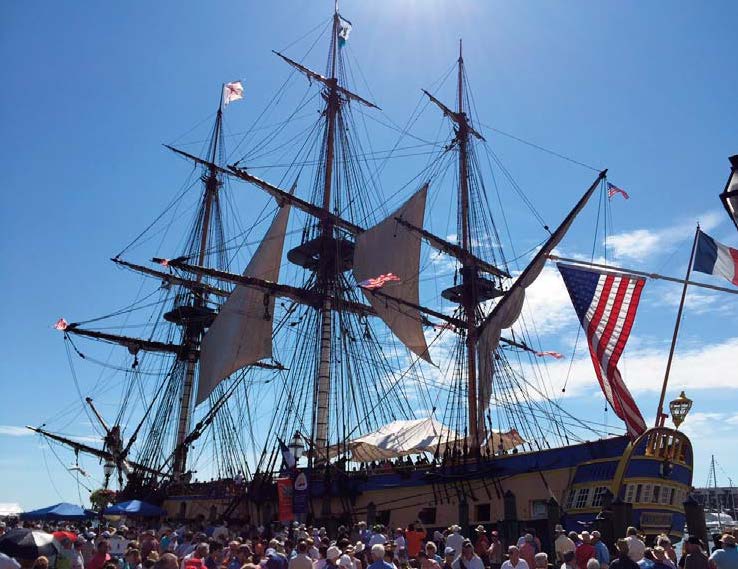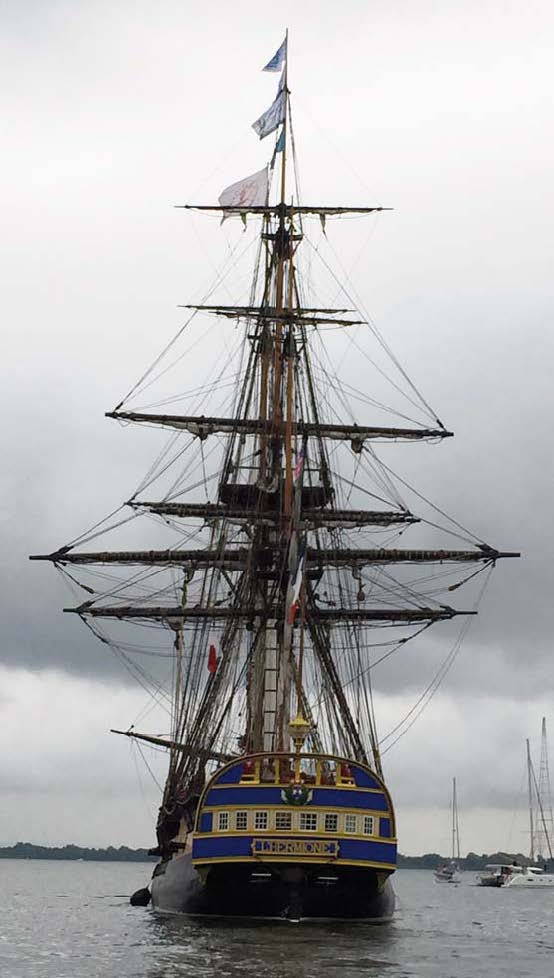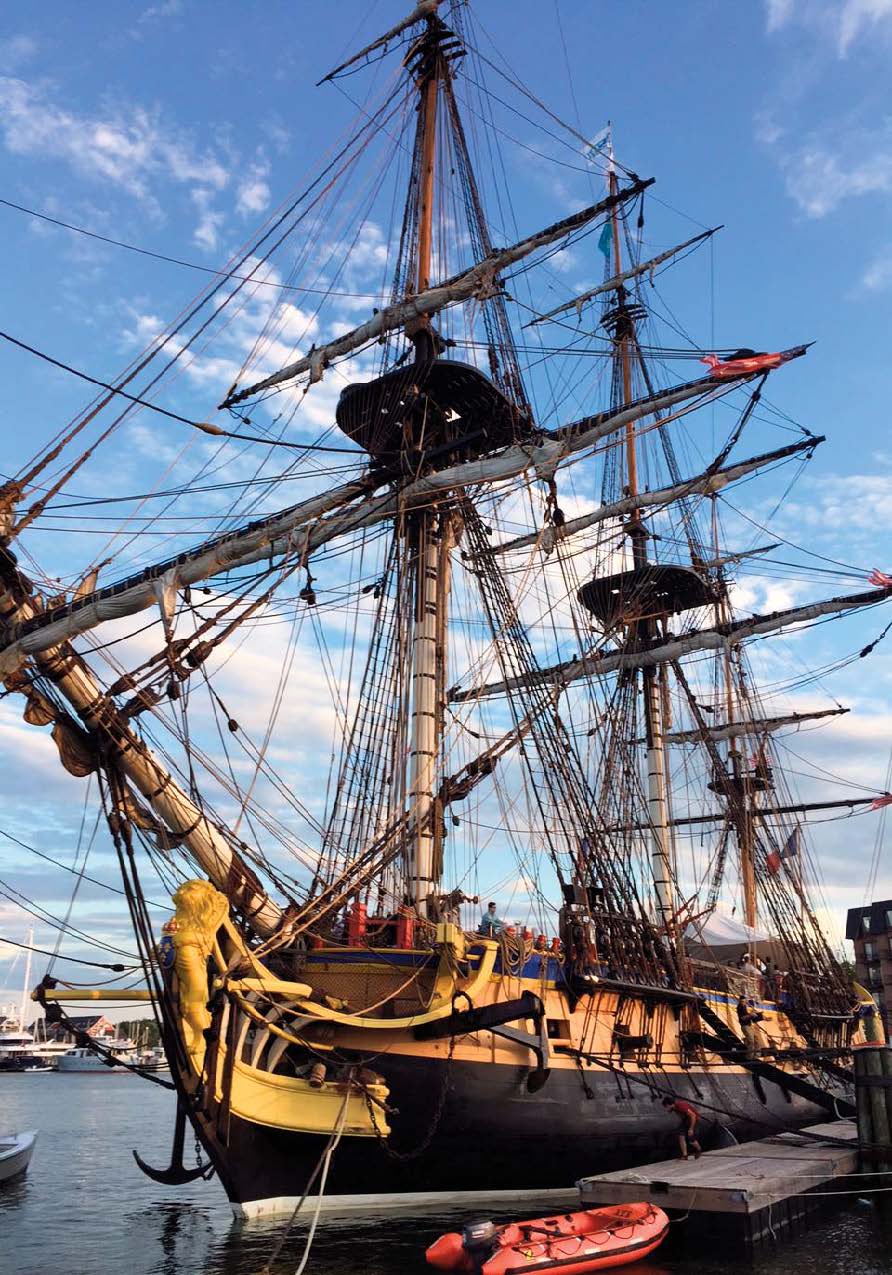L'HERMIONE Returns to the Chesapeake
Text and photos by Emmy Nicklin CBF's Senior Manager of Digital Media

Annapolis City Dock can be an eerily empty place at dawn. But that was hardly the case last Thursday when a French frigate readied to sail north. A replica of the 18th-century, square-rigged vessel that carried Revolutionary War Hero Marquis de Lafayette to the Americas 235 years ago, L'HERMIONE is the largest and most authentically built tall ship in the last century. And she is currently (June 6-July 15) touring 12 iconic Revolutionary War ports from Yorktown, Virginia, to Castine, Maine. The voyage, which originated in Rochefort, France, celebrates the extraordinary French-American bond and Lafayette's indomitable spirit of adventure (as exemplified in his motto: "Cur Non" or "Why not").
Roughly 10 months before I found myself on City Dock that morning, my sister, who has the unfortunate burden of living in Paris, City of Light, with her French husband and two young daughters, stood along the shores of Île d'Aix to bear witness to the historic moment when L'HERMIONE sailed for the first time. The ship that took 17 years to build uses the same materials and techniques (such as oak timbers, linen sails, and hemp lines) that were available in the 18th century. And she's gorgeous— 155 ft high, 217 ft long, drawing 16 ft, powered by 17 sails and two electric propulsion engines (connected to diesel generators), and intricately detailed with yellow trim and ornate carvings.

L'HERMIONE as Science Lab
Not only does L'HERMIONE serve as a history lesson, she also serves as science lab and research vessel. Throughout the ship's Atlantic crossing, the Director of Maritime Operations for the Friends of Hermione-Lafayette in America Marc Jensen worked with the U.S. National Oceanic and Atmospheric Administration (NOAA) and its global counterpart, the Joint Technical Commission for Oceanography and Marine Meteorology (JCOMM), to deploy a series of 11 climate buoys (one of which he placed about 100 miles from the mouth of the Chesapeake). These buoys join a network of hundreds of others that collect and transmit data like water temperature, barometric pressure, position, and salinity back to the Global Drifter Program website.
In addition to better understanding our environment and the ways that we can protect and restore it, Jensen has other aspirations for what this L'HERMIONE voyage can teach us: "I certainly hope that when people walk aboard the ship [they realize that] the reason this is all happening is that a young man convinced his king to support a revolution. [He had] the understanding that an individual's freedom is a right that you're born with . . We can't ever underestimate the power of what young people can do once they set their mind to something."
Lafayette and the Chesapeake
What would Lafayette have eaten on his voyages in the Chesapeake? That's what CBF's Senior Naturalist (and all-around Bay/History/Life Expert in my mind), John Page Williams and I find ourselves discussing the day that L'HERMIONE leaves Annapolis.
"It was a different Bay, for sure, back then," Williams says as he waxes poetic about the spot, croaker, sheepshead, American shad, salt herring, and rockfish (some averaging 60 pounds!) that swam thick and healthy across the Bay and its rivers in Lafayette's time. Not to mention the massive, vertical oyster reefs that grew so abundantly in the Chesapeake that they posed navigational hazards to passing ships.
"Our ability to alter the system was much lower [back then]—we didn't have the tools to do it," says Williams referring to trawl nets, dredging, and clear-cutting machinery. "The worst damage we did came in the last 180 years," Williams continues, "[when we were] beating up the land without realizing it during the Industrial Revolution and the 20th Century." The numbers speak for themselves. Since Lafayette's time, we have lost more than 40 percent of our forested buffers that once grew deep and undisturbed across 110,000 miles of rivers and streams and that filtered and cleaned our water; roughly 80 percent of our underwater grasses that once flourished across 400,000 acres, sheltering sea horses, juvenile fish, blue crabs, and more; and more than 90 percent of our water-filtering oysters.
"But this is not the way it has to be," Williams insists. Perhaps he, in persistent Lafayette fashion, cannot lose hope that that we can impact powerful, lasting change on the world around us—whether it be the birth of a nation or the rebirth of the Chesapeake.
"We've seen improved sewage treatment bring the Potomac and James Rivers back from the dead," says Williams. "Bald eagles and ospreys rebound; and Atlantic sturgeon begin to spawn again in several of the Chesapeake's rivers. There are still plenty of problems, but improvements like these tell us that the Chesapeake system wants to live, and that with a lot of thought and effort, we can restore more of its riches than any of us has seen in a long time.”
"Cur Non"
Back at City Dock on that early morning, as the rain starts to fall and a small crowd of Annapolitans gathers to wish L'HERMIONE adieu, a strange thing happens. A girl, not so unlike my eldest French-American niece 20 years from now, clambers up the ratlines— why exactly, I can't be sure. She climbs higher and higher, with determination and perseverance, throwing leg over leg, hand over hand, refusing to look down. She climbs high above the heads of her crewmates who serenade us with loud French sea chanties as they leave the dock. And I imagine her still climbing in the distance as the ship passes by the old Naval Academy transmitter towers, where, rumor has it, the D-Day Invasion orders were sent across the Atlantic. She keeps climbing as high as she can possibly go because . . . Why Not?
Sign up to learn more about our Bay, rivers, and streams, and how you can help save them now and for generations to come: http://www.cbf.org/news-media/enewsletters/registration


